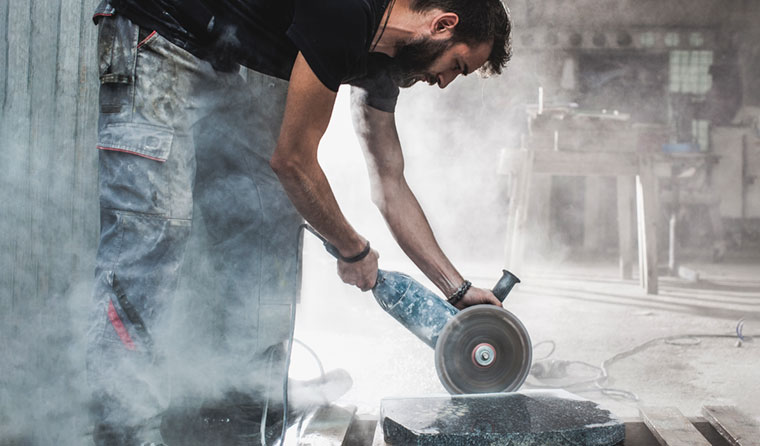Chronic silicosis typically develops over 10 or more years of exposure to low levels of respirable crystalline silica.
There are increasing reports of young men in the United States, Australia and other countries developing an incurable lung disease that can cause massive scarring of both lungs. The destruction of lungs makes breathing difficult and often leads to death unless the patient is lucky enough to get a lung transplant. Who are these men and what is this disease? They all have something in common. They are manual workers who cut and fabricate countertops using engineered stone referred to as quartz. Engineered quartz is 93-97% crystalline silicon dioxide combined with resins and binders. While cutting the slab of quartz, silica dust is released into the air. By breathing in this dust silica particles become trapped in lung tissue thereby causing inflammation and scarring such that lungs cannot transfer oxygen. This condition is called silicosis. Silicosis is caused by breathing in very fine (“respirable”) dust containing crystalline silica, also commonly known as silica, silica dust, or quartz. In industrial settings, especially in the mining industry exposure to respirable crystalline silica a prevalent, widely recognized, and one of the oldest known occupational exposures.
Initially, the workers may be developing disease without respiratory symptoms. Chronic silicosis typically develops over 10 or more years of exposure to low levels of respirable crystalline silica. However, high levels of exposure can cause faster development of the disease. The common symptoms experienced are cough, shortness of breath, fatigue and chest pain. The diagnosis is usually made through a chest radiograph and computerized tomography (CT scans). Silicosis is often mistakenly diagnosed as tuberculosis thereby prompting unnecessary treatment with drugs for tuberculosis.
The health department in California has recently identified 77 cases of silicosis, out of whom at least ten needed lung transplant and at least ten others died. Unfortunately, there is no effective treatment for this condition that can reverse or slow down the progression of lung scarring. Stopping further exposure to silica dust can help preserve residual lung function but in many patients the disease can continue to progress. Unfortunately, many workers continue as before even after the diagnosis because of the financial constraints and limited opportunities. Silicosis also predisposes workers to developing lung cancer, chronic bronchitis and autoimmune diseases.
Quartz countertops are resistant to heat or scratching and considered largely maintenance-free. Quartz is increasingly used for the construction and renovation of kitchens and bathrooms globally, and especially in the Asia Pacific region. The global quartz market is anticipated to increase at a compound annual growth rate (CAGR) of > 10% between 2022 and 2028. Quartz surfacing materials may contain up to 93% crystalline silica while the percent of crystalline silica in granite is less than 45%.
Since there is no treatment for this disease prevention is the key. The key to prevention is keeping dust out of the air. Whenever possible, cutting, grinding and shaping of the slabs and the countertops should be done wet. Ventilation and filtration systems should be used to collect silica-containing dust in the factories. If these engineering controls fail to eliminate the risk, then use of a N95 respirator is recommended. Periodic medical monitoring helps to detect silicosis at early stages so workers can avoid further exposure and potentially limit progression of disease. Considering the challenges in implementing preventative strategies nationwide the Indian government should consider banning engineered stone products as is being implemented in Australia.
Dr Ajay Gupta, MBBS (AIIMS), MD-Medicine (AIIMS), is Clinical Professor of Medicine, University of California Irvine, USA

